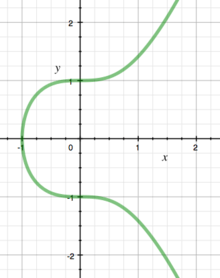Mordell curve
In algebra, a Mordell curve is an elliptic curve of the form y2 = x3 + n, where n is a fixed non-zero integer.[1]

These curves were closely studied by Louis Mordell,[2] from the point of view of determining their integer points. He showed that every Mordell curve contains only finitely many integer points (x, y). In other words, the differences of perfect squares and perfect cubes tend to ∞. The question of how fast was dealt with in principle by Baker's method. Hypothetically this issue is dealt with by Marshall Hall's conjecture.
Properties
If (x, y) is an integer point on a Mordell curve, then so is (x, -y).
There are certain values of n for which the corresponding Mordell curve has no integer solutions;[1] these values are:
- 6, 7, 11, 13, 14, 20, 21, 23, 29, 32, 34, 39, 42, ... (sequence A054504 in the OEIS).
- -3, -5, -6, -9, -10, -12, -14, -16, -17, -21, -22, ... (sequence A081121 in the OEIS).
In 1998, J. Gebel, A. Pethö, H. G. Zimmer found all integers solutions for 0 < |n| ≤ 104.[3] (Data on Mordell's curves for –10000 ≤ n ≤ 10000, OEIS: A081119, OEIS: A081120).
Example
Fermat proved that the only integer solutions of are .
References
- Weisstein, Eric W. "Mordell Curve". MathWorld.
- Louis Mordell (1969). Diophantine Equations.
- Gebel, J.; Pethö, A.; Zimmer, H. G. (1998). "On Mordell's equation". Compositio Mathematica. 110 (3): 335–367. doi:10.1023/A:1000281602647.